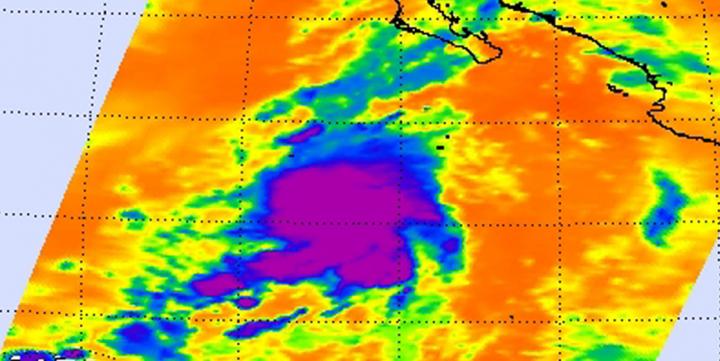NASA sees shapeless Tropical Depression 14E

This false-colored infrared image from NASA's Aqua satellite showed southwesterly vertical wind shear is pushing the thunderstorms to the northeast of Tropical Depression 14E's center on Sept. 2 at 5:05 a.m. EDT. Credits: NASA JPL, Ed Olsen
NASA's Aqua satellite passed over Tropical Depression 14E on September 2 at 0905 UTC (5:05 a.m. EDT).
The Atmospheric Infrared Sounder or AIRS instrument aboard looked at Tropical Depression 14E in infrared light and saw that strong convection (rising air that creates the thunderstorms that make up a tropical cyclone) had increased since Sept. 1, however, southwesterly vertical wind shear is pushing the thunderstorms to the northeast of the center.
At 11 a.m. EDT (1500 UTC) the center of Tropical Depression Fourteen-E was located near latitude 16.2 North and longitude 115.0 West. That's about 570 miles (915 km) southwest of the southern tip of Baja California.
The depression was moving toward the north near 9 mph (15 kph) and this general motion is expected to continue through the next couple of days.
A turn toward the north-northeast with a reduced forward speed is forecast Thursday night.
Maximum sustained winds are near 35 mph (55 kph) and the National Hurricane Center noted that the depression still could become a tropical storm later on September 2. For updated forecasts, visit: http://www.
Media Contact
All latest news from the category: Earth Sciences
Earth Sciences (also referred to as Geosciences), which deals with basic issues surrounding our planet, plays a vital role in the area of energy and raw materials supply.
Earth Sciences comprises subjects such as geology, geography, geological informatics, paleontology, mineralogy, petrography, crystallography, geophysics, geodesy, glaciology, cartography, photogrammetry, meteorology and seismology, early-warning systems, earthquake research and polar research.
Newest articles

Superradiant atoms could push the boundaries of how precisely time can be measured
Superradiant atoms can help us measure time more precisely than ever. In a new study, researchers from the University of Copenhagen present a new method for measuring the time interval,…

Ion thermoelectric conversion devices for near room temperature
The electrode sheet of the thermoelectric device consists of ionic hydrogel, which is sandwiched between the electrodes to form, and the Prussian blue on the electrode undergoes a redox reaction…

Zap Energy achieves 37-million-degree temperatures in a compact device
New publication reports record electron temperatures for a small-scale, sheared-flow-stabilized Z-pinch fusion device. In the nine decades since humans first produced fusion reactions, only a few fusion technologies have demonstrated…





















